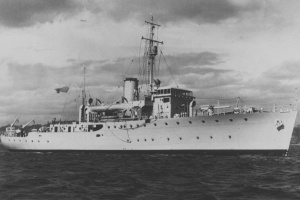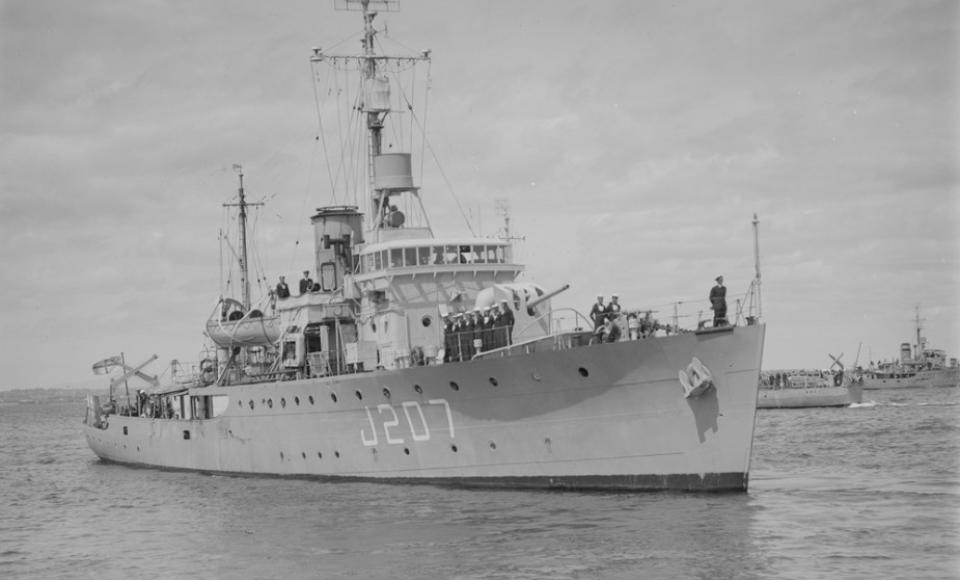HMAS Mildura was one of 60 Australian Minesweepers (commonly known as corvettes) built during the Second World War in Australian shipyards as part of the Commonwealth Government’s wartime shipbuilding program. Twenty were built on Admiralty order but crewed and commissioned by the Royal Australian Navy (RAN). Thirty-six (including Mildura) were built for the RAN and 4 for the Royal Indian Navy.
HMAS Mildura was laid down at Morts Dock Engineering Company, Balmain, Sydney, New South Wales on 23 September 1940. It was launched on 15 March 1941 by Mrs J (Marie) Durnford, wife of the Second Naval Member and was the first RAN warship to carry the name of the north-west Victorian regional city. By the war’s end Mort’s Dock had constructed 14 of the 60 Bathurst class corvettes.
After fitting out, Mildura commissioned at Sydney on 23 July 1941, under the command of Lieutenant George E V G Owen RANR(S).
The ship joined the 20th Minesweeping Flotilla on 29 August 1941, and operated as a unit of the Flotilla until it was disbanded late in 1941. Until August 1942 Mildura was engaged in minesweeping, escort duties and anti-submarine patrols in Australian and South Pacific waters.
From September 1942 to December 1943 it operated as one of the escort vessels protecting the movement of Australian east coast convoys. During this period 11 merchant ships were sunk by Japanese submarine off the east coast with a loss of 407 lives.
In January 1943 Mildura assisted in the salvage and tow to Sydney of the impaired American vessel SS Peter Burnett which had been torpedoed some 530 miles east of Sydney. Several attacks were made on convoys escorted by Mildura. The Australian vessel SS Iron Knight was torpedoed without warning and sank in 2 minutes, with the loss of 37 lives on 8 February 1943.
From January to July 1944, Mildura served on anti-submarine patrol duty in Queensland waters and as escort to convoys proceeding from Townsville to New Guinea. In August 1944 it was transferred to the operational control of the Naval Officer-in-Charge, Fremantle, arriving at that port on 30 August. Until the end of the year it joined with other ships to provide escort and anti-submarine patrols, mainly in the approaches to Fremantle.
Following a refit at Fremantle, Mildura transferred to the control of the Naval Officer-in-Charge, New Guinea, on 14 March 1945. Proceeding via Darwin it arrived at Port Moresby on 28 March 1945, proceeding thence to Morotai. At Morotai it operated as a stationery patrol vessel interspersed with escort duty to Biak.
On 22 June 1945 it went to Tarakan, Borneo, where it carried out dusk-to-dawn harbour approach patrols, returning to Morotai on 1 July. En route a party was landed on Makelhi Island to search for the crew of a wrecked Catalina flying boat sighted on the beach. The rest of July was spent at Morotai interspersed with escort duty between Zamboanga and Borneo.
Following 2 week of patrols and guardship service at Balikpapan, Mildura went to Subic Bay in the Philippines where it joined 7 ships of the same class to form a RAN Minesweeping Flotilla. The group arrived at Hong Kong on 30 August 1945.
Following a period of boiler cleaning, patrolling, rounding up enemy small craft and taking over the Hong Kong brewery from the Japanese, Mildura was allocated as a unit of the 21st Minesweeping Flotilla in mid-September 1945. Minesweeping operations with the flotilla in Chinese waters continued until 17 October 1945. On 20 October, at Hong Kong, it went ‘on the first stage of the long and keenly awaited return to Australia.’ It reached Sydney on 19 November 1945 after an absence of 2 years and 7 days.
Following a refit Mildura resumed service in February 1946 as a unit of the 20th Minesweeping Flotilla. Operations with the flotilla clearing minefields in Australian, New Guinea and Solomon Islands waters kept its fully occupied until October 1947. On 16 January 1948 it reached Fremantle, where it paid off on 21 May 1948.
Mildura recommissioned at Fremantle on 20 February 1951 for service as a training ship, under the command of Lieutenant John Ferguson DSC RAN. In this capacity it served in Western Australian waters, training national service trainees, until 1953, after which it went to Melbourne.
Mildura paid off at Melbourne on 11 September 1953, having steamed 208 132 miles since first commissioning in July 1941. On 8 December 1954 the tug HMAS Sprightly departed Melbourne with Mildura in tow. The vessels arrived at Brisbane on 15 December. At Brisbane Mildura served as an immobilised reserve training ship.
Mildura was sold for scrap on 8 September 1965 to Brisbane Non-Ferrous Pty Ltd.
Specifications
 |
| Class |
Bathurst Class |
|---|---|
| Type |
Australian Minesweeper |
| Pennant |
J207 |
| Builder |
Mort"s Dock & Engineering Co Ltd, Sydney |
| Laid Down |
23 September 1940 |
| Launched |
15 March 1941 |
| Launched by |
Mrs Durnford, wife of the Second Naval Member |
| Commissioned |
23 July 1941 |
| Decommissioned |
11 September 1953 |
| Dimensions & Displacement | |
| Displacement | 650 tons |
| Length | 186 feet |
| Beam | 31 feet |
| Draught | 8 feet 6 inches |
| Performance | |
| Speed | 15 knots |
| Complement | |
| Crew | 85 |
| Propulsion | |
| Machinery | Triple expansion, 2 shafts |
| Horsepower | 1750 |
| Armament | |
| Guns |
|
| Other Armament |
|
| Awards | |
| Battle Honours |
|
